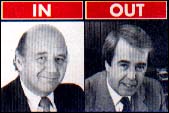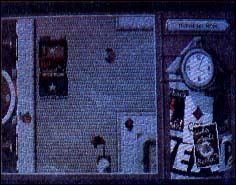News, Notes & Quotes
BY STEPHEN MORTIMER, START CONTRIBUTING EDITOR
Inside Atari
- There's been yet another change of management at Atari. Mike Morand is no longer President of Atari Computer. David Harris, from the consumer products division, is now in charge of the computer division. Reportedly the change in management was amicable and was the result of personal reasons on the part of Morand.

David Harris Mike Morand - The Stacy 2 and Stacy 4 have passed FCC Class A certification. This frees the computer for business/industrial use, although no actual restrictions on sales are made by the FCC. Both systems come with the respective amount of memory and a 40MB Conner hard disk drive. The Stacy 1, floppy-disk version has not yet been approved.
- Look for a new version of GDOS in 1990. It will use the UltraScript based fonts and use Imagen's smooth scaling software for screen representations. This will not be a Postscipt interpreter. Only the fonts from UltraScript will be used. Also, look for a multitasking TOS. According to Leonard Tramiel, multitasking is a "logical" extension of the operating system.
- Atari filed suit against Nintendo and codefendant Pepsico. The suit cites false advertising, unfair trade practices and unfair competition. All this comes as the result of ads that Atari claim were deceiving because of references to nonexistent color features on Nintendo's GameBoy. Nintendo is currently under Federal investigation for alleged monopolistic competition and unfair trade practices.
- Some new technical specifications for the STE have come to light. The four SIMM memory units protrude through the internal shielding of the STE, allowing for easy upgrades. The 68000 is a square, socketed PLCC chip. This, according to Jim Allen of Fast Technology, will make a possible Turbo 16e upgrade very easy to install, requiring no soldering. Finally, the GLUE chip has now grown to an 84-pin monstrosity and the MMU and shifter chip have been combined into one large surface mount chip. In mid December, STEs began trickling into Canada.
- Rainbow TOS 1.4, contrary to reports, is a very solid operating system. Only a few programs, mainly games, are incompatible with this improved OS. Stories claiming that it has only compatibility with 60 percent of existing ST software are false.A conservative estimate places it well over 90 percent. Atari has now made available a two-chip set version of Rainbow TOS (part number CA400407). If your system originally had two chips, but was upgraded to the six-chip Rainbow TOS, and is having problems, try the two-chip version. There is an overloading problem with the six-chip set in some STs.
- Some final tidbits: STs were featured on the hit TV series "Growing Pains" and "Who's the Boss." Also, the American Stock Exchange is planning to make an Atari stock option available, pending approval from the Securities and Exchange Commission.
Xerox Sues Apple
Is Apple getting a dose of its own medicine? Maybe. Xerox is suing Apple Computer for $ 150 million, contending that Apple misrepresented the originality of the Macintosh's and Lisa's graphics-based interface. Xerox is seeking $100 million in royalties and $50 million in damages due to the misrepresentation.
The Xerox Star and Smalltalk were systems designed in the late 1970s that used mice, windows, dialog boxes, menus and icons. Steve Jobs, then at Apple, was shown Smalltalk in 1979 and was very impressed with its user-friendly interface. Additionally, several employees of Xerox went to work for Apple in the early 1980s, giving Apple access to copyrighted material.
Apple, who is suing Hewlett-Packard and Microsoft for infringement on their graphical-interface copyrights, says the suit is without merit since ideas cannot be protected by copyright. Xerox's suit may be weakened by the fact that they licensed Apple to implement Smalltalk on Apple hardware. Also, Xerox has waited five years since the Mac's introduction to file the lawsuit
Fat Bits
- Creative Microsystems, Inc. (CMI), the accelerator-board manufacturer, has gone out of business.
- Look for Atari to make a big splash in the new, open Eastern Europe, especially East Germany. The U.S. is considering the relaxation of its ban on export restrictions on computers to the countries in transition. This might allow the ST to be sold in this huge potential market.
- ISD has shipped DynaCADD 1.7 to dealers. The new version of the popular CAD program retails for $995 and includes many additional features along with a new 600 page manual.
- Bad news for Arkanoid fans: Taito has ceased development on the ST and a planned release of Arkanoid II has been postponed indefinitely. A company spokesperson cited "smaller then expected sales" for Taito products in the ST market as the major reason for the decision.
If you have a hot Atari news item, let us know at News, Notes & Quotes, START Magazine, 544 Second Street, San Francisco, CA 94107.
EUROPEAN REPORT
BY DONALD MAPLE, REPORTING FROM WEST GERMANY
The ST market in Europe is quite different from the North American one. Not only is the ST one of the most popular game machines over here but it's also considered to be a serious business computer. While France and the U.K. supply the bulk of games, Germany has produced a plethora of excellent professional software. This monthly report will focus on what's happening in Europe as it affects the ST community--use this column as a kind of crystal ball as to what lies ahead for the U.S. since most European products have a way of showing up there eventually.
 |
| The Cold War revisited: East vs. West, a new spy thriller from West German game-maker Rainbow Arts. |
All Work and No Play?
Rainbow Arts, a German software company, has just announced two new games for the ST. East vs. West is an "agent-simulation" game taking place during the Berlin airlift in 1948. The game revolves around an A-bomb stolen from an American base in the U.K. Sam Porter is the U.S. secret agent who has the task of preventing the bomb from being passed on to the Soviets.
Conqueror is a tank simulation that boasts 16 different tank types roaming through 3D fractal landscapes. There are three different game types: action, attrition and strategy. Rainbow Arts negotiates their U.S. distribution for each game separately so I can't tell you where to get these games yet.
(On a side note: with the Berlin Wall rapidly acquiring the complexion of Swiss cheese and the [long overdue] revival of "peace and love," the above Cold-Warmongering games are a bit out of place.)
Back to BASICs
One of the more sizeable and interesting shipments released in West Germany is from a company called Omikron. The name may not mean much to you, but over here it's identified with ST BASIC. This is primarily due to the fact that, in Europe, Omikron BASIC is shipped as standard with all ST computers. The only exceptions to this are France and the U.K.
Omikron BASIC is a superset of Microsoft MBASIC and as such is 99 percent compatible with it. Among almost 300 commands, which cover all of the standard BASIC keywords, are also various mathematical functions (ARCTAN, SINH, EXP, etc), system variables (MOUSEX, MOUSEY etc), structured programming control commands (REPEAT-UNTIL, WHILE-WEND, PROC etc) and sequential and random disk file access commands. In addition to interfacing with AES, VDI, GEMDOS, BIOS and XBIOS, Omikron BASIC is also able to do limited multitasking.
The program operates on two screens: a comfortable editor screen with menu bar on top and the familiar "OK" run/command screen. The compiler, sold separately for 179 deutsch marks (about $100), takes programs created using the interpreter and produces stand-alone .PRG files. These programs are then not only executable directly from the Desktop but run between two and 27 times faster than the interpreted versions. Both Omikron BASIC and the compiler are available in English.
Another Omikron program called 2nd_Word is a word processor with a peculiar difference: in order to run the program, you have to lay your monitor on its side. The screen then corresponds to the printed page perfectly. This is known as "portrait" in the desktop publishing industry. Unfortunately, the program runs on monochrome monitors only. In Germany the program retails for 59 deutsch marks (about $32). At this time the program is in German only.
Omikron is currently seeking a North American distributor. (Omikron, Erlachstrasse, 157534 Birkenfeld 2, West Germany, (7082) 50048.)
Yugoslavian Program Does It All
STeve, which stands for "ST event editor" is an integrated "everything" program. Written by Primoz Jakopin of Yugoslavia, STeve has built a sizeable following as it spreads across the continent. There are now over 1,000 STeve users.
It is difficult to describe STeve because it does so many different things. The reference manual itself is a 600-page hardback. So here is a list of some of the features found in version 3.292: a database, a desktop publisher, a word processor, an image processor (including scanning), a spreadsheet--the list goes on. The program can be heavily customized by the use of over 30 user modifiable system tables. But don't let the complexity scare you since everything is quite clearly laid out. (Primoz Jakopin, Trnovska 261000, Ljubljana, Yugoslavia, (61) 226-329.)
Steve Mortimer is a contributing editor for START and lives in Binghamton, New York. Donald Maple is Canadian by origin and presently lives and works in Dusseldorf, West Germany. He wrote "TT-TOS Secrets" in the February 1990 issue of START.